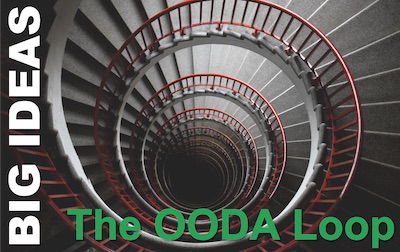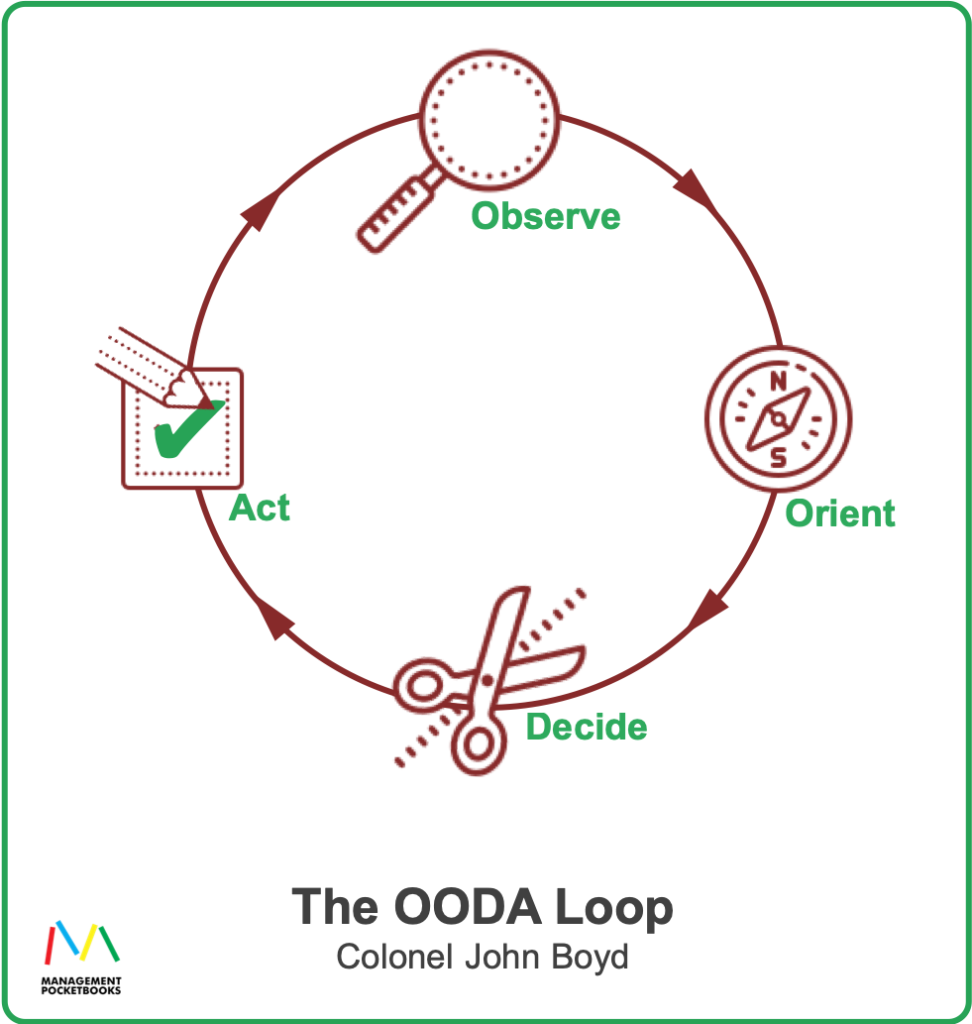

The OODA Loop is is an idea that arose within the US military in the 1960s. It was developed by Colonel John Boyd. But the principles are broader than military theory, and managers can get a lot from them.
When I first learned about the OODA Loop, there was very little available to read about it. A few highly technical papers by military strategists, and copies of Boyd’s original seminar notes.
Now, there is a lot more available on the web. But almost all of it still focuses on the military applications. I want to see what the OODA Loop offers us more widely.
Where Does the OODA Loop Come From?
John Boyd was a US Airforce officer, who saw active service in both the Korean and Vietnamese conflicts, in the 1960s and 1970s. As a fighter pilot, and as a fighter pilot trainer, he developed ideas of tactical air superiority. These led to the US military investing its fighter plane development in more manoeuvrable aircraft. Boyd is sometimes known as the father of the F16.
In my assessment, the OODA Loop started out as a way for Boyd to describe the cognitive aspects of aerial combat. It placed a premium on rapid assessment of the situation, and decision-making. Later, Boyd would extend his thinking to a more all-encompassing military theory. Numerous junior officers (at the time) and some US politicians gathered around Boyd, and adopted his ideas.
What is the OODA Loop?
One problem we have is that almost all Boyd’s thinking was relayed in conversation or in mammoth day-long seminars. He wrote down very little. Another is, frankly, a combination of eclectic and sometimes obscure references, combined with a context (the military and warfare) that is outside the experience of most of us.
Whilst it can be a hobby topic for some non-military people to understand Boyd’s theories of warfare, I certainly don’t propose to offer them to you. I am far from qualified. And this does expose me to the risk that suitably qualified military thinkers will brand my assessment of the OODA Loop as simplistic.
So be it. A simple explanation of the OODA Loop has tremendous value in thinking about your professional and managerial practice.
The OODA Loop is a Cycle
The OODA loop is a four-stage cycle for selecting, acting on, and revising your response to changes in your environment. Here is an illustration.

The four steps in the OODA Loop cycle are:
- Observe
Use your senses and your other data-gathering resources to gather information from your environment. - Orient
Make sense of that information, by deploying:- Experience and prior knowledge
- Rational thinking and reason
- Intuition and instinct
- Decide
Select the best course of action - Act
Implement your decision
Then, observe the outcome of your actions and continue around the loop.
Cycle Time Matters
In military engagements, Boyd argued that the pace with which you cycle around your OODA Loop will determine your success. In aerial combat, for example, he argued that the pilot who moved around the OODA Loop fastest would have an advantage. Hence his advocacy for fighter jets with maximum manoeuvrability.
The idea of ‘getting inside your opponent’s OODA Loop’ has become well known – almost clichéd – in US military circles. But the concept is a good one.
Project Management
If you are managing a project and you are cycling around the loop at a faster rhythm than events, you are likely to feel more in control of your project. In project management, we call this the monitor and control cycle.
Likewise, in negotiation or workplace conflict, you’ll find that reading the situation and responding flexibly and rapidly will give you an advantage. It’s no coincidence that the project management concept of Agile has become pervasive as a desideratum for organisational cultures, in the form of ‘Agility’.
How to Apply the Idea of the OODA Loop in Business and Civilian Life
Beyond project management, I find the OODA Loop helpful in:
- Personal time management: constantly reprioritizing your day to handle the interruptions and incidents that characterise modern life
- Discussion, influence, and negotiation: you can always be alert for new information about the other person’s position, interests, and approach, that can inform the way you tackle persuasion
- Leadership and management: we often hear that we work in a VUCA world (Volatile, Uncertain, Complex, and Ambiguous). So, the need to constantly reassess and adapt our approach is vital
Has the OODA Loop been updated in the last 60 Years?
Yes, there are always new ideas. Defence scientist, David Bryant developed the CECA Loop, of:
- Critique
- Explore
- Compare
- Adapt
Do take a look at our article from 2010.
What is your experience of this type of constant re-evaluation?
We’d love to hear your experiences, ideas, and questions. Please leave them in the comments below.
To learn more…
The Management Models Pocketbook was, I think, the first mainstream management book to include the OODA Loop. It will give you a more thorough understanding of the idea.
